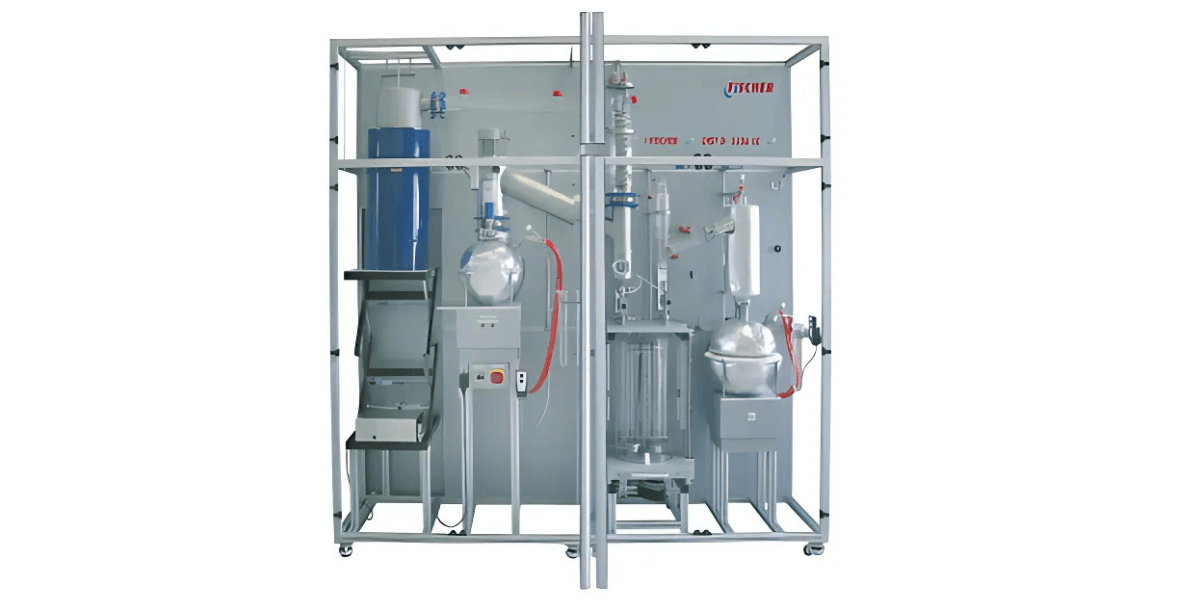Sustainable Innovations in ASTM D5236 Testing Methods

Sustainable innovations in ASTM D5236 testing methods are becoming increasingly relevant as the petroleum industry looks for ways to refine heavy hydrocarbon mixtures more efficiently.
ASTM D5236, the vacuum potstill method, is widely used to analyze crude oil samples, providing crucial data on distillation fractions and crude oil stability. As refineries process whole crude oil and heavy crude oil, optimizing test methods for accuracy and efficiency remains a priority.
Recent developments in distillation technology focus on improving vacuum stability, fraction collection, and real-time monitoring, which can enhance the reliability of ASTM D5236 results. These refinements contribute to a more precise characterization of petroleum fractions, supporting better decision-making in refining processes.
This blog examines key advancements in ASTM D5236 testing, including improved distillation techniques, data collection methods, and industry trends shaping the future of petroleum analysis.
Key Takeaways
- Sustainable innovations in ASTM D5236 testing improve efficiency, reduce waste, and enhance accuracy for refineries and research labs.
- Advanced vacuum control and automation make distillation processes more precise, consistent, and environmentally friendly.
- Performance Distillation Solutions delivers cutting-edge ASTM D5236 systems designed for accuracy, sustainability, and maximum efficiency.
The Role of ASTM D5236 in Hydrocarbon Distillation
ASTM D5236, the Vacuum Potstill Method, is a key test method for analyzing heavy crude oil, residues, and synthetic mixtures.
Unlike standard distillation, which operates at atmospheric pressure, this method uses vacuum conditions to separate high-boiling fractions without excessive thermal decomposition. This allows for more accurate determination of distillation fractions in heavy hydrocarbon mixtures.
One of its primary applications is measuring atmospheric equivalent temperature (AET), which helps predict how petroleum fractions behave under refining conditions. By providing detailed temperature and fraction yield data, ASTM D5236 supports decision-making in refining and research, particularly for crude oil stability and distillation processes.
Importance in refining and petrochemical industries
ASTM D5236 is widely used in the petroleum industry to assess crude oil samples and optimize production processes:
- Refineries use it to evaluate distillation fractions, improving yield predictions and refining efficiency.
- Research labs apply it to study crude oil behavior, refining test methods, and developing industry data.
Challenges in Traditional ASTM D5236 Testing
While ASTM D5236 is essential for analyzing heavy crude oil and distillation fractions, traditional methods come with limitations. High energy consumption, waste management concerns, and accuracy issues can impact efficiency and sustainability.
High energy consumption: Maintaining deep vacuum levels and high temperatures for distillation requires significant energy, increasing operational costs. Long processing times further slow crude oil analysis, limiting efficiency in production processes.
Waste and environmental impact: Processing heavy hydrocarbon mixtures generates residues that may not always be reusable, adding to refinery waste. Some fractions contain high sulfur content or other chemical properties that require additional treatment. Vacuum distillation can also contribute to emissions, raising environmental concerns.
Accuracy and reproducibility issues: Manual handling and vacuum fluctuations affect the consistency of ASTM D5236 results. Variability in flow rate, temperature, and test methods can impact the accuracy of petroleum fraction analysis, making reproducibility a challenge.
Sustainable Innovations in ASTM D5236 Testing Methods
As the petroleum industry refines more heavy crude oil and complex mixtures, advancements in ASTM D5236 testing are improving distillation efficiency, accuracy, and sustainability.
New technologies address challenges in energy consumption, waste management, and test method reproducibility, making production processes more reliable and environmentally responsible.
Advanced vacuum technology for energy efficiency
Stable vacuum conditions are essential in ASTM D5236, as they influence temperature control, fraction separation, and overall test accuracy.
Innovations in vacuum regulation now allow for deeper cuts with lower energy consumption, helping refineries reach higher atmospheric equivalent temperatures (AET) without excessive heat input. These improvements enhance efficiency in processing heavy hydrocarbon mixtures while maintaining sample integrity.
Automated and computer-controlled distillation systems
Traditional ASTM D5236 testing requires significant manual oversight, which can introduce variability.
Automated and computer-controlled systems now adjust vacuum levels, flow rate, and temperature in real time, improving reproducibility and reducing human error. Smart monitoring systems streamline data curation and optimize test methods, making distillation fractions more consistent for refineries and research labs.
Complementary separation techniques in ASTM D5236 analysis
While ASTM D5236 remains a core test method for analyzing heavy crude oil, other techniques, such as supercritical fluid extraction and molecular distillation, are sometimes used alongside it to enhance sample preparation and fraction analysis.
These methods help separate specific chemical components before or after ASTM D5236 testing, providing additional insight into aromatic compounds, functional groups, and other chemical properties. By refining sample composition, they support a more accurate characterization of petroleum fractions in distillation processes.
Waste reduction and sustainable fraction handling
New fraction collection systems are improving the handling of distillation fractions, reducing product loss, and increasing reusability. Cold traps capture excess vapors, minimizing emissions and contamination in oil samples.
These innovations contribute to more sustainable heavy oil processing while helping refineries meet environmental and efficiency goals.
The Future of ASTM D5236
Environmental regulations and technological advancements are driving changes in ASTM D5236 testing.
Refineries and research labs are adopting new test methods, automation, and improved distillation processes to enhance efficiency, accuracy, and sustainability. While implementation varies across facilities, these innovations are shaping the future of heavy crude oil analysis.
Regulatory compliance and environmental pressures
Stricter environmental policies are pushing refineries to adopt cleaner distillation practices. ASTM standards continue to define sustainability benchmarks, requiring better management of sulfur content, aromatic compounds, and other chemical properties in crude oil samples.
Many refineries are refining waste reduction strategies, optimizing fraction collection, and upgrading test methods to minimize emissions and energy consumption.
AI and machine learning in distillation optimization
AI and machine learning are improving ASTM D5236 testing by enabling real-time data analysis and predictive process control.
AI-driven simulated distillation models help optimize temperature and flow rate settings for better fraction separation. Machine learning can also detect vacuum fluctuations and process irregularities, enhancing consistency while reducing energy use and costs.
The shift toward greener solvents and alternative distillation fluids
As sustainability becomes a priority, refineries are exploring alternatives to traditional solvents like n-heptane and toluene to reduce environmental impact. Some are investigating hybrid distillation methods that combine vacuum separation with lower-impact solvents to improve efficiency.
While adoption varies, advances in distillation processes and solvent selection are helping the industry meet sustainability targets.
Why Choose Performance Distillation Solutions for ASTM D5236?

Reliable equipment is key to precise and efficient ASTM D5236 testing. Performance Distillation Solutions (PDS) offers advanced systems that refine heavy hydrocarbon mixtures, reduce test time, and support sustainable distillation practices.
Our technology delivers accurate crude oil analysis, making it the top choice for refineries, research labs, and petrochemical facilities.
Cutting-edge ASTM D5236 equipment
Our DIST D-5236 CC and DIST D-5236 HV models provide exceptional performance for crude oil samples and petroleum products.
With advanced vacuum control reaching 0.006 mmHg, these systems ensure precise separation of high-boiling fractions. This accuracy is essential for characterizing heavy oil, refining test methods, and generating reliable distillation data.
Sustainability and efficiency benefits
PDS is committed to sustainability without compromising performance. Our systems feature:
- Automatic vacuum reduction to shorten test time and optimize energy use.
- Dead volume elimination, ensuring accurate weight vs. temperature data.
- Energy-efficient fraction collection, reducing fluctuations that can impact test consistency.
These innovations help refineries and labs improve efficiency while reducing waste, aligning with industry efforts to refine heavy crude oil more responsibly.
Ideal for refineries, labs, and petrochemical facilities
Our ASTM D5236 solutions cater to a wide range of industries:
- Refineries benefit from improved distillation processes, maximizing valuable yield while minimizing energy consumption.
- Research labs rely on precise test methods for characterizing crude oil stability, molecular weight, and other key chemical properties.
- Petrochemical facilities use our systems to maintain consistent vacuum conditions, which are essential for processing complex mixtures and ensuring product quality.
Seamless user experience with real-time monitoring
A fully computer-controlled interface allows for real-time adjustments, ensuring precise, repeatable results. Users can monitor temperature, flow rate, and fraction collection with ease, while automated reporting simplifies formal analysis and compliance documentation.
For refineries, research labs, and petrochemical teams seeking reliable ASTM D5236 solutions, Performance Distillation Solutions offers precision, efficiency, and sustainability.
Our advanced systems, including ASTM D1160 for vacuum distillation and ASTM D2892 for crude oil fractionation, provide comprehensive testing for crude oil samples and heavy hydrocarbon mixtures. Contact us today to learn how our cutting-edge equipment can enhance your distillation and petroleum analysis operations.
Conclusion
Advancements in ASTM D5236 testing are reshaping how refineries and research labs analyze crude oil samples and refine heavy hydrocarbon mixtures.
Sustainable innovations in distillation technology, automation, and test methods are improving efficiency, reducing waste materials, and enhancing the accuracy of petroleum product analysis. As environmental regulations tighten, adopting these solutions helps facilities optimize fraction collection, minimize energy consumption, and refine the complex nature of heavy crude oil.
Staying ahead in crude oil analysis requires reliable, high-performance equipment. Performance Distillation Solutions provides cutting-edge ASTM D5236 systems designed for precision, sustainability, and efficiency. Upgrade to industry-leading distillation solutions today—where precision meets sustainability.
Frequently Asked Questions
What are the ASTM methods of analysis?
ASTM methods are standardized test methods used to analyze the properties and chemical composition of crude oil, heavy hydrocarbon mixtures, and petroleum products.
These tests provide reliable data on sulfur content, molecular weight, aromatic rings, and temperature stability, helping refineries and labs maintain quality, improve production processes, and meet industry regulations.
What are ASTM D6653 standard test methods?
ASTM D6653 evaluates how packaging holds up under low-pressure conditions, such as air transport. While not directly related to oil samples or distillation, it’s essential for industries shipping sensitive materials that could be affected by altitude changes.
Ensuring product stability during transport helps maintain safety and quality across various industries.
What is the ASTM D323 method?
ASTM D323 measures the vapor pressure of petroleum products, including crude oil and heavy oil. This test is key to determining how volatile a fuel is, which impacts storage, handling, and safety.
Knowing the vapor pressure of oil samples helps refineries optimize production, prevent losses, and ensure compliance with transportation regulations.
